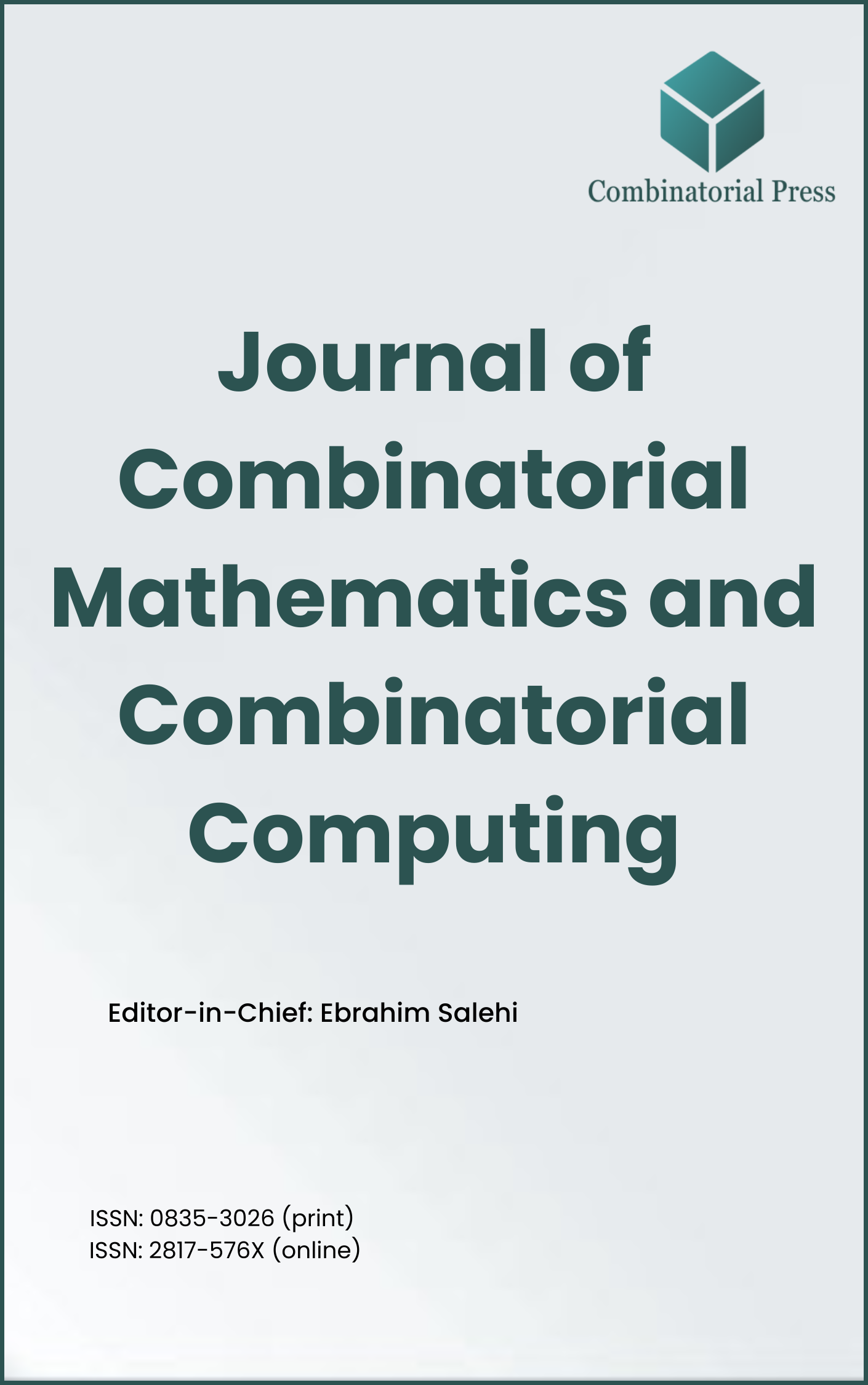
Journal of Combinatorial Mathematics and Combinatorial Computing
ISSN: 0835-3026 (print) 2817-576X (online)
The Journal of Combinatorial Mathematics and Combinatorial Computing (JCMCC) embarked on its publishing journey in April 1987. From 2024 onward, it publishes four volumes per year in March, June, September and December. JCMCC has gained recognition and visibility in the academic community and is indexed in renowned databases such as MathSciNet, Zentralblatt, Engineering Village and Scopus. The scope of the journal includes; Combinatorial Mathematics, Combinatorial Computing, Artificial Intelligence and applications of Artificial Intelligence in various files.
- Research article
- Full Text
- Journal of Combinatorial Mathematics and Combinatorial Computing
- Volume 014
- Pages: 61-64
- Published: 31/10/1993
In this paper, we prove that
- Research article
- Full Text
- Journal of Combinatorial Mathematics and Combinatorial Computing
- Volume 014
- Pages: 39-60
- Published: 31/10/1993
A set of blocks which is a subset of a unique
- Research article
- Full Text
- Journal of Combinatorial Mathematics and Combinatorial Computing
- Volume 014
- Pages: 33-37
- Published: 31/10/1993
The support of a
- Research article
- Full Text
- Journal of Combinatorial Mathematics and Combinatorial Computing
- Volume 014
- Pages: 15-32
- Published: 31/10/1993
The problem of task allocation in distributed systems has been studied by many researchers. Several approaches have been used to model and study the problem, including integer programming, heuristic methods, and graph theoretic models. These approaches considered only restricted forms of the general problem. In this paper, we introduce a new model to represent the problem of allocating tasks on heterogeneous distributed systems. The model consists of a complete split graph that represents the communication cost among tasks as well as the execution cost of each task on the system processors. This model allows the incorporation of various constraints into the allocation problem. We show that the task allocation problem is equivalent to the problem of weighted clique partitioning in complete split graphs, which we proved to be NP-complete. We present a clique partitioning algorithm that employs the properties of split graphs for solving the problem in its general form. We show that the algorithm generates optimal solutions in some cases, while performing fairly well in general.
- Research article
- Full Text
- Journal of Combinatorial Mathematics and Combinatorial Computing
- Volume 014
- Pages: 3-13
- Published: 31/10/1993
This paper discusses new Erdös-Gallai type necessary conditions for a sequence
- Research article
- Full Text
- Journal of Combinatorial Mathematics and Combinatorial Computing
- Volume 013
- Pages: 213-222
- Published: 30/04/1993
A graph
-
-
- no tree
It is known that the problem of finding an OCT is NP-hard for graphs
- Research article
- Full Text
- Journal of Combinatorial Mathematics and Combinatorial Computing
- Volume 013
- Pages: 193-212
- Published: 30/04/1993
A graph is said to be
- Research article
- Full Text
- Journal of Combinatorial Mathematics and Combinatorial Computing
- Volume 013
- Pages: 187-192
- Published: 30/04/1993
It is proved in this paper that there exists a simple
- Research article
- Full Text
- Journal of Combinatorial Mathematics and Combinatorial Computing
- Volume 013
- Pages: 175-186
- Published: 30/04/1993
An efficient algorithm for calculating the chromatic polynomial of large graphs relative to the tree basis is presented. As an application of this algorithm, the degree thirty-two chromatic polynomial of the dual of the truncated icosahedron is calculated. Before this algorithm, only the by-hand calculations of Hall, Siry, and Vander-slice, completed in 1965, had produced this chromatic polynomial.
- Research article
- Full Text
- Journal of Combinatorial Mathematics and Combinatorial Computing
- Volume 013
- Pages: 167-174
- Published: 30/04/1993
Generalized difference sets are difference sets with prescribed (and possibly different) multiplicities for every element. In this paper, constructions will be given for generalized difference sets on the semigroup of positive integer for almost every possible multiplicity function (sequence of multiplicities).





